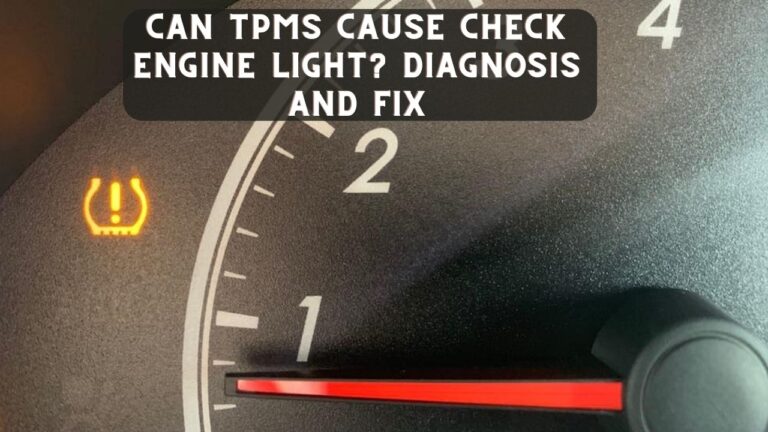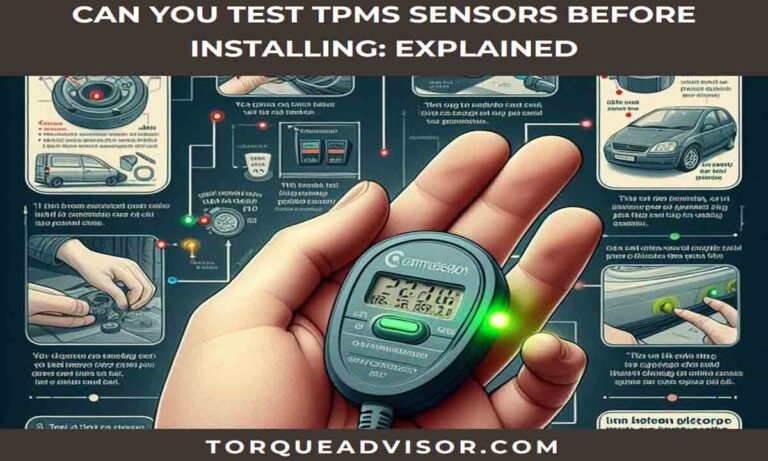What Is The Difference Between TPMS Relearn And Program?
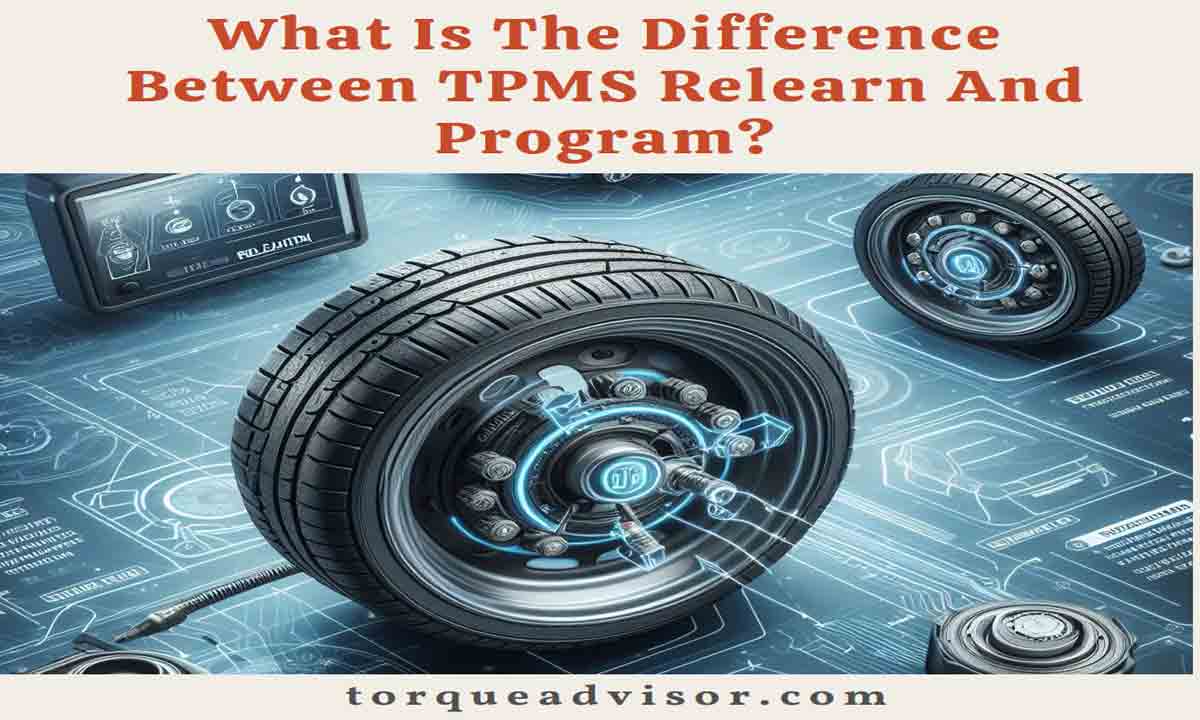
TPMS alerts drivers to low tire pressure, enhancing safety, extending tire life, and improving fuel efficiency. But what is the difference between TPMS relearn and program?
TPMS programming assigns a sensor to a specific vehicle. TPMS relearning informs the vehicle about sensor-tire associations. Both processes ensure accurate tire pressure monitoring.
TPMS Relearn:
Function: Informs the vehicle’s TPMS system about the location of each individual tire pressure sensor.
When it’s needed:
- After replacing a TPMS sensor
- When rotating tires (in some vehicles)
- After the battery is disconnected
- If the TPMS warning light comes on and the tire pressures are correct
How it works: Each sensor has a unique ID, and the relearn process pairs that ID with the specific wheel position on the vehicle. This allows the system to track and display the pressure for each individual tire.
Usually a simple process: Most vehicles have a dedicated relearn procedure that can be done through the car’s menu system or using specialized tools.
TPMS Programming:
Function: Configures the TPMS sensor with vehicle-specific information.
When it’s needed:
- When using aftermarket TPMS sensors (universal or “cloneable”) that are not pre-programmed for your vehicle.
- If a sensor malfunctions and needs to be replaced with a non-pre-programmed one.
How it works: Programming involves assigning the sensor’s ID, frequency, and other vehicle-specific data. This ensures compatibility with your car’s TPMS system and allows it to properly interpret the sensor’s signals.
Requires specialized tools and knowledge: Programming usually requires a TPMS programming tool and specific instructions for your vehicle. It’s often recommended to have a professional handle this step.
Here’s an analogy to illustrate the difference:
- Think of TPMS relearn as teaching a language lesson. You’re telling the system which words (sensor IDs) belong to which objects (wheel positions).
- TPMS programming is like setting up a communication device. You’re configuring the device (sensor) with the correct settings so it can communicate properly with the network (TPMS system).
In summary:
- TPMS relearn: Tell the system where the sensors are.
- TPMS programming: Tell the sensors how to talk to the system.
What Is The Difference Between TPMS Relearn And Program?
| Aspect | TPMS Relearn | TPMS Programming |
| Purpose | Synchronize existing sensors with the vehicle’s computer. | Configure the TPMS system to recognize new sensors. |
| When to Perform | After replacing or rotating tires, replacing a TPMS sensor, or when sensor communication issues arise. | When adding new sensors to the vehicle, such as aftermarket sensors or replacing the entire TPMS unit. |
| Process | Puts the TPMS system into a learning mode to recognize and store unique identification codes of each sensor. | Configures the TPMS system to recognize the unique identification codes of new sensors. |
| How it Works | Pairs sensor IDs with wheel positions. | Assigns sensor ID, frequency, and other vehicle-specific data. |
| Frequency | Periodic, as needed when sensor-related maintenance is performed. | Typically a one-time setup for new sensors. |
| Complexity | Usually simple, often DIY-friendly. | Requires specialized tools and knowledge, often done by a professional. |
| Analogy | Teaching a language lesson. | Setting up a communication device. |
TPMS relearning and programming serve distinct functions in tire pressure monitoring systems. Programming a sensor assigns it to a specific vehicle, ensuring it communicates relevant data accurately.
This process directly links the sensor and the vehicle’s monitoring system. In contrast, TPMS relearn focuses on the vehicle’s recognition of individual sensors within its tire configuration.
It instructs the vehicle to recognize the unique identifiers of each sensor, ensuring proper tire-to-sensor mapping.
The cars’s ECU stores the unique IDs from the 4(or 5) sensors along with their respective positions to ensure that the vehicle accurately identifies the tire IDs.
While programming associates a sensor with a vehicle, relearning ensures the vehicle registers and monitors each sensor’s location and data, optimizing safety and performance.
Read More About 9 Best Aftermarket TPMS Sensors For Any Budget & To Enhance Tire Safety
What Does TPMS Stand For?
TPMS stands for “Tire Pressure Monitoring System.” It is an electronic system designed to monitor the air pressure inside the tires on various types of vehicles, such as cars, trucks, and buses.
What Is A TPMS Relearn?
A TPMS (Tire Pressure Monitoring System) relearn is a procedure to reset or recalibrate the system after tire rotation, replacement, or sensor change. It ensures accurate tire pressure readings and alerts for optimal safety and performance.
What Is Tpms Programming?
TPMS programming involves configuring or reprogramming the sensors in a vehicle’s tires. Properly programmed TPMS sensors ensure accurate tire pressure readings, enhancing safety and optimizing vehicle performance.
What Is Programmable Tpms?
Programmable TPMS (Tire Pressure Monitoring System) allows users to adjust and customize settings, such as pressure thresholds, to suit specific vehicle requirements. This flexibility ensures accurate tire pressure monitoring and enhances safety while driving.
Tpms Programming Tool
1. Smart Sensor TPMS Programming Tool
The Smart Sensor TPMS Programming Tool offers efficient tire pressure monitoring system (TPMS) programming. Designed for accuracy and ease of use, it ensures precise sensor configuration, enhancing vehicle safety and performance. An essential tool for modern automotive maintenance.
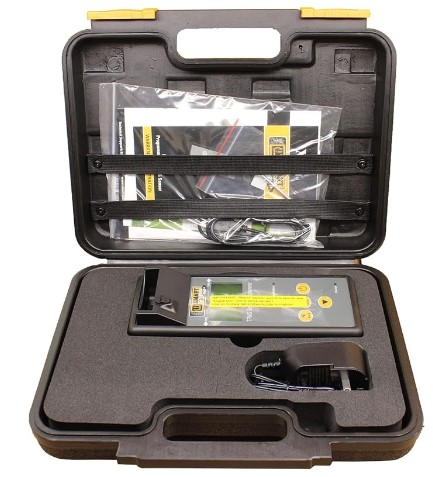
2. Astro Pneumatic TPMS Programming Tool
Astro Pneumatic TPMS Programming Tool is a trusted device for TPMS calibration. Known for its durability and reliability, it simplifies sensor programming tasks. Engineered for professionals, it ensures optimal tire safety and consistent performance on the road.
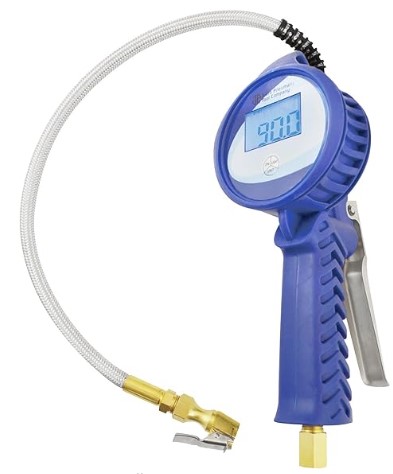
Tpms Relearn Tool
1. SpassLeben TPMS Relearn Tool
SpassLeben TPMS tool offers efficient tire pressure monitoring system relearning. Designed for accuracy, it ensures vehicles maintain optimal tire pressure, enhancing safety and performance. Its user-friendly interface simplifies the relearn process, making it a trusted choice for car enthusiasts.
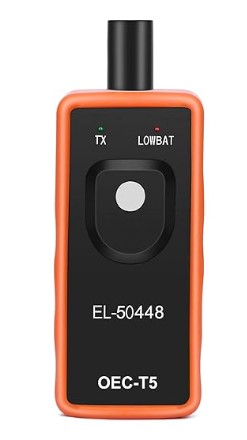
2. JDIAG T TPMS Relearn Tool
The JDIAG T TPMS Relearn Tool stands out with its advanced features tailored for modern vehicles. Ensuring precise tire pressure readings, it guarantees safety and efficiency. Its intuitive design and compatibility with various models make TPMS relearning hassle-free. A go-to tool for professional diagnostics.
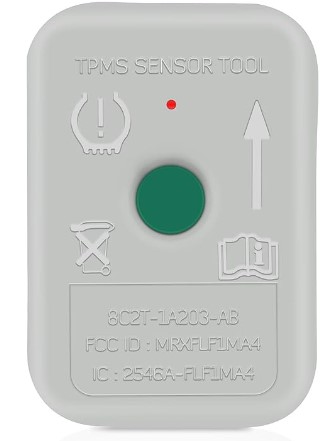
Universal Tpms Programming Tool
1. JDIAG Universal Tire Pressure Monitor Sensor Tool
The JDIAG Universal TPMS Tool offers precise tire pressure monitoring, ensuring optimal safety and performance. Compatible with various vehicles, it simplifies sensor programming, making it an essential tool for tire maintenance and diagnostics.
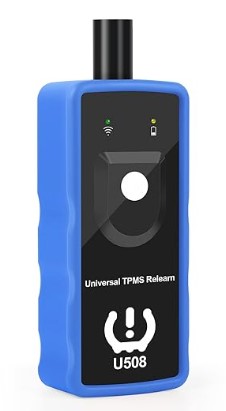
2. VXDAS Universal Tire Pressure Monitor Sensor TPMS
VXDAS TPMS ensures accurate tire pressure readings, promoting fuel efficiency and prolonging tire life. Its universal compatibility and user-friendly interface make tire monitoring effortless, enhancing vehicle safety and overall driving experience.
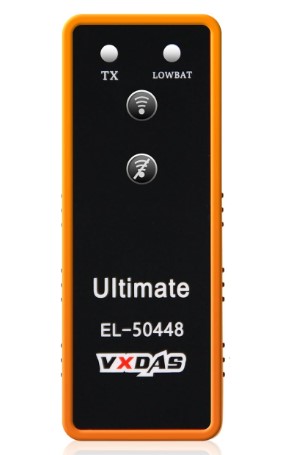
What Are The Different Types Of Relearn?
Here are the types of relearn methods commonly encountered:
- Auto Relearn (Auto Learn)
This is the most convenient method and is often found in newer vehicles. Once the tires are properly inflated and the vehicle is driven at a certain speed for a specific duration. The TPMS system automatically detects the tire pressure and identifies each tire’s position.
- Stationary (Manual) Relearn
In this method, you might need a TPMS tool or device.
It involves going to each tire and using the TPMS tool to activate the sensor. The tool sends a signal to the sensor, which then transmits its ID to the vehicle’s TPMS module.
- OBD (On-Board Diagnostic) Relearn:
Some vehicles can use the OBD port and a diagnostic tool to reset the TPMS system. The procedure varies depending on the vehicle and the TPMS tool being used.
Where Are TPMS Located?
TPMS sensors are located inside the tire, typically attached to the wheel rim. They monitor tire pressure and send data to the vehicle’s onboard computer, alerting the driver if the pressure is too low or high.
How Does TPMS Auto Relearn Work?
TPMS auto relearn allows a vehicle’s system to automatically recognize new tire pressure sensors. When sensors are replaced or rotated, the vehicle’s TPMS initiates a relearning process.
This involves activating each sensor in a specific sequence, allowing the system to register and store their unique IDs. This ensures accurate tire pressure readings and alerts.
How Do Tpms Sensors Communicate With Ecu?
TPMS sensors communicate with the ECU using radio frequency signals. Each sensor transmits tire pressure data to the ECU, which interprets the information and alerts the driver if tire pressure is below the recommended level.
How Long Do TPMS Sensors Last?
TPMS sensors typically last between 5 to 10 years, but their lifespan can vary based on usage, environmental conditions, and other factors.
How Do I Reset My TPMS?
Here are general steps you can follow:
Step 1: Ensure Correct Tire Pressure
Before resetting, ensure that all tires are inflated to the recommended pressure as indicated in your vehicle’s owner’s manual.
Step 2: Check for the Reset Button
Some vehicles have a dedicated TPMS reset button. If yours does, the location will be specified in the owner’s manual.
Step 3: Start the Vehicle
Turn on the ignition without starting the engine.
Step 4: Locate the TPMS Reset Button
If your vehicle has a reset button, press and hold it until the TPMS warning light blinks a few times. The exact procedure can vary between vehicle models, so refer to your owner’s manual for specific instructions.
Step 5: Check for TPMS Light
Once you start driving, monitor the TPMS light on the dashboard. It should go off after a short drive if there are no issues with the tire pressures.
Step 6: Drive for a Bit
Some vehicles might require driving at a certain speed or distance to fully reset the TPMS. Refer to your owner’s manual for any specific requirements.
Step 7: Verify the System
After resetting, always verify that the TPMS system is working correctly by ensuring the TPMS light illuminates briefly when you start the vehicle, indicating that the system is performing a self-check.
Read Also Can You Test TPMS Sensors Before Installing: Explained
How Do I Check My TPMS?
Here’s how you can check your TPMS:
1. Vehicle Dashboard
Start your vehicle and look at the instrument panel when the ignition is on but the engine is not running.
If there’s a TPMS warning light (often depicted as an exclamation point inside a tire shape) illuminated, it indicates that at least one of your tires is under-inflated.
2. TPMS Display
If your vehicle has this feature, navigate through the vehicle’s menu on the infotainment system or dashboard display to access the TPMS information.
3. Manual Check
To manually check:
- Remove the valve stem cap from the tire.
- Press the tire pressure gauge firmly onto the valve stem. You should hear a hiss of air escaping, and the gauge will give you a reading.
- Compare the reading with the recommended pressure. If the reading is significantly lower, you’ll need to add air to the tire.
How To Activate New TPMS Sensor Without Tool
Here’s a general method that might work for some vehicles:
- Start with a Full Battery: Ensure your vehicle’s battery is fully charged. A weak battery might cause communication issues with the TPMS system.
- Ensure Proper Tire Pressure: Before attempting any procedure, ensure that all tires are inflated to the recommended pressure as specified by the vehicle manufacturer.
- Initiate the TPMS Reset Mode: Some vehicles have a reset button or sequence that allows you to reset the TPMS system. Check your vehicle’s owner manual for instructions on how to initiate the TPMS reset mode.
- Drive the Vehicle: In some cases, simply driving the vehicle for a few miles at varying speeds might trigger the TPMS system to recognize the new sensor.
Can You Reprogram TPMS Sensors To A Different Vehicle?
Yes, you can reprogram TPMS sensors to a different vehicle by:
- Obtaining the TPMS sensor’s ID using a diagnostic tool.
- Selecting the vehicle year and model on the diagnostic tool.
- Ensuring compatibility and installing the sensor.
- Initiating the programming with the installed sensor.
What Does TPMS Light Mean?
The TPMS light indicates tire pressure issues. A steady light means improper tire pressure; intermittent lighting suggests borderline pressure changes, often due to temperature. If the light flashes briefly and stays on, there’s likely a TPMS system malfunction. Immediate attention may prevent further complications.
How To Read TPMS?
To access your TPM settings, simply press Windows+R and input tpm.msc. This will open the TPM Management console. Look for details on your TPM version; if it’s listed, you have TPM.
For more specific TPM data, enter ‘tpmtool getdeviceinformation’. Upon launching tpm.msc, the console will indicate whether your TPM is ready for use or if there’s an incompatibility issue.
Read Also Can TPMS Cause Check Engine Light? Diagnosis And Fix
FAQs
What is the benefit of TPMS?
TPMS (Tire Pressure Monitoring System) enhances vehicle safety by alerting drivers to under-inflated tires. Proper tire pressure ensures optimal traction, longer tire life, improved fuel efficiency, and reduces the risk of blowouts.
What are the benefits of using multi-application sensors?
Multi-application sensors offer versatility, reducing the need for specialized sensors for different tasks. They streamline integration, simplify maintenance, and enhance cost-effectiveness by serving various functions within diverse environments and applications.
Does Redi-sensor work with TPMs?
Yes, Redi-sensor is a universal TPMS (Tire Pressure Monitoring System) sensor designed to work with various vehicles. It provides compatibility and ease of installation for many TPMS applications.
Are there any downsides to using multi-application sensors?
Yes, downsides include increased complexity, potential for cross-application interference, higher costs due to integrated features, and the need for specialized maintenance and expertise. Proper integration and management are essential to optimize performance and reliability.
Conclusion
We hope now you understand what is the difference between TPMS relearn and program. TPMS (Tire Pressure Monitoring System) relearn and program are distinct processes. Relearn involves resetting the system to recognize new tire sensors or after tire rotations. It does not alter sensor data.
Programming, however, modifies the sensor’s ID or information within the system, often required when replacing a sensor. Both ensure accurate tire pressure readings but serve different purposes in TPMS maintenance.

